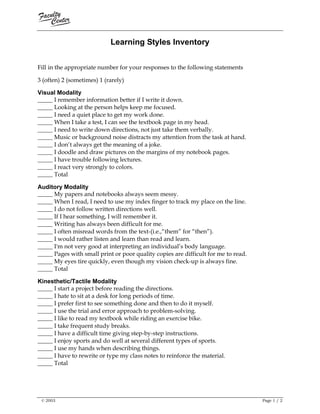More Related Content
Similar to Learning stylesinventory
Similar to Learning stylesinventory (20)
More from BP KOIRALA INSTITUTE OF HELATH SCIENCS,, NEPAL
More from BP KOIRALA INSTITUTE OF HELATH SCIENCS,, NEPAL (20)
Learning stylesinventory
- 1. Learning Styles Inventory
Fill in the appropriate number for your responses to the following statements
3 (often) 2 (sometimes) 1 (rarely)
Visual Modality _____ I remember information better if I write it down. _____ Looking at the person helps keep me focused. _____ I need a quiet place to get my work done. _____ When I take a test, I can see the textbook page in my head. _____ I need to write down directions, not just take them verbally. _____ Music or background noise distracts my attention from the task at hand. _____ I don’t always get the meaning of a joke. _____ I doodle and draw pictures on the margins of my notebook pages. _____ I have trouble following lectures. _____ I react very strongly to colors. _____ Total
Auditory Modality _____ My papers and notebooks always seem messy. _____ When I read, I need to use my index finger to track my place on the line. _____ I do not follow written directions well. _____ If I hear something, I will remember it. _____ Writing has always been difficult for me. _____ I often misread words from the text-(i.e.,“them” for “then”). _____ I would rather listen and learn than read and learn. _____ I'm not very good at interpreting an individual’s body language. _____ Pages with small print or poor quality copies are difficult for me to read. _____ My eyes tire quickly, even though my vision check-up is always fine. _____ Total
Kinesthetic/Tactile Modality _____ I start a project before reading the directions. _____ I hate to sit at a desk for long periods of time. _____ I prefer first to see something done and then to do it myself. _____ I use the trial and error approach to problem-solving. _____ I like to read my textbook while riding an exercise bike. _____ I take frequent study breaks. _____ I have a difficult time giving step-by-step instructions. _____ I enjoy sports and do well at several different types of sports. _____ I use my hands when describing things. _____ I have to rewrite or type my class notes to reinforce the material. _____ Total
© 2003 Page 1 / 2
- 2. Total the score for each section. A score of 21 points or more in a modality indicates a strength in that area. The highest of the 3 scores indicates the most efficient method of information intake. The second highest score indicates the modality which boosts the primary strength. For example, a score of 23 in the visual modality indicates a strong visual learner. Such a learner benefits from the text, from filmstrips, charts, graphs, etc. If the second highest score is auditory, then the individual would benefit from audio tapes, lectures, etc. If you are strong kinesthetically, then taking notes and rewriting class notes will reinforce information.
Clues
Learning Tips
Visual Learners Usually:
• Need to see it to know it
• Have strong sense of color
• May have artistic ability
• Often have difficulty with spoken directions
• May Over-react to sounds
• May have trouble following lectures. Often misinterprets words
Visual Learners Should:
• Use graphics to reinforce learning; films, slides, illustrations, diagrams and doodles
• Color code to organize notes and possessions
• Ask for written directions
• Use flow charts and diagrams for notetaking
• Visualize spelling of words or facts to be memorized
Auditory Learners Usually:
• Prefer to get information by listening- needs to hear it to know it
• May have difficulty following written directions
• Difficulty with reading
• Problems with writing
• Inability to read body language and facial expressions
Auditory Learner Should:
• Use of tapes for reading and for class and lecture notes
• Learning by interviewing or by participating in discussions
• Having test questions or directions read aloud or put on tape
Kinesthetic Learners Usually:
• Prefer hands-on learning
• Often can assemble parts without reading directions
• Have difficulty sitting still
• Learn better when physical activity is involved
• May be very well coordinated and have athletic ability
Kinesthetic Learners Should:
• Engage in experiential learning (making models, doing lab work, and role playing)
• Take frequent breaks in study periods
• Trace letters and words to learn spelling and remember facts
• Use computer to reinforce learning through sense of touch
• Memorize or drill while walking or exercising
• Express abilities through dance, drama or gymnastics
Adapted from the Tutor Trainer’s Manual, Tyler Junior College, Tyler,TX.
© 2003 Page 2 / 2

